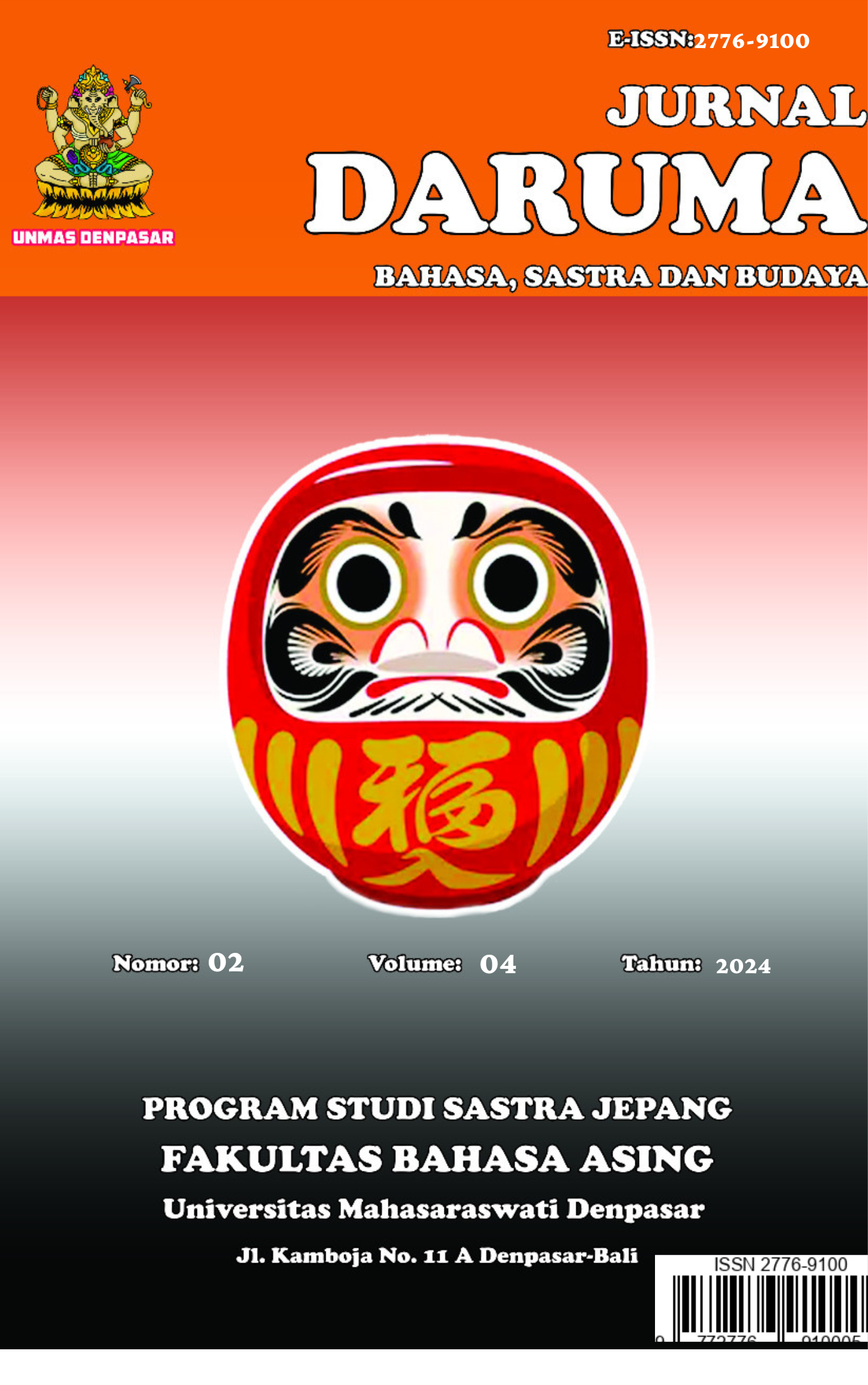ANALISIS MAKNA ADJEKTIVA “OOKII DAN DEKAI” DALAM KALIMAT BAHASA JEPANG
Keywords:
Kata kunci: Semantik, Sinonim, Ookii dan DekaiAbstract
Language is a tool for conveying an idea or idea and is also often used by humans to convey information. Therefore, this research was written with the aim of understanding the differences in the synonyms for the adjectives ookii and dekai in Japanese sentences using qualitative descriptive methods. The qualitative descriptive method is a very important method used in writing scientific articles. This method is used to examine a problem so as to find conclusions from the research being studied. The theory used in this research is the contextual meaning theory according to Pateda, (2010:116) which states that contextual meaning is contextual meaning or situational meaning. Situational meaning arises as a result of the relationship between utterance and context. The results of this research show that the adjective ookii can be used to indicate big in the sense of: a country, an animal, a building, a room, the size of a piece of clothing and abstract size. Meanwhile, the adjective "dekai" expresses size in terms of: an object, an animal, abstract size, the size of a person, buildings and cities. The adjective dekai cannot be used to express the size of clothes or rooms while the adjective "ookii" can.
References
Anggraeni, Y. (2012). Analisis penggunaan ureshii, tanoshii dan yorokobu dalam kalimat bahasa jepang. Chi'e: Journal of Japanese Learning and Teaching, 1(1).
Bloch, B., Trager, G. L., & Trager, G. L. (1942). Outline of linguistic analysis. USA:Linguistic Society of America.
Harimurti Kridalaksana, 1939-. (1986.). Kelas kata dalam bahasa Indonesia/
Harimurti Kridalaksana. Jakarta, Gramedia,.
Keraf, Gorys. 2004. Komposisi: Sebuah Pengantar Kemahiran Bahasa. Flores: Nusa Indah.
Kridalaksana, Harimurti. 1983. Kamus Linguistik. Jakarta: Gramedia Pustaka.
Nikmah, J. (2017). Penggunaan Adjektiva Tekitou Dan tadashii Sebagai Sinonim Dalam Kalimat Bahasa Jepang. Fakultas Ilmu Budaya Universitas DiponegoroEprints. undip. ac. id/51930/1/SKRIPSI_LENGKAP. pdf.
Oktaviana, G. (2012). Adjektiva bermakna kesungguhan majime, shinken dan honki. Jurnal satu tinjauan semantik, 1, 9-15.
Pramana, I. G. N. B., & Aritonang, B. D. (2021, June). Analisis Perbedaan Kata Kerja Okuru, Annai Suru, Dan Tsureru Dalam Kalimat Bahasa Jepang. In Prosiding Seminar Sastra Budaya dan Bahasa (SEBAYA) (Vol. 1, No. 01, pp. 60-67).
Putri, I. D. D. (2023). Sinonim adjektiva utsukushii dan kireida dalam bahasa Jepang: Kajian Semantik. Jurnal SORA-Pernik Studi Bahasa Asing, 3(2), 90-101.
Verhaar, J.W.M. 2006. Asas-asas Linguistik. Yogyakarta: Gadjah mada university Press.
Wahyu, I. W. W. C. W., Meidariani, N. W., & Wijaya, G. T. (2023). The Analysis Of Adjectives Tsurai, Kurushii And Kutsuu In Japanese Language Ruigigo. SPHOTA: Jurnal Linguistik dan Sastra, 15(1), 43-53.
Walija. 1996. Bahasa Indonesia dalam Perbincangan. Jakarta: IKIP Muhammadiya
Jakarta Press.





